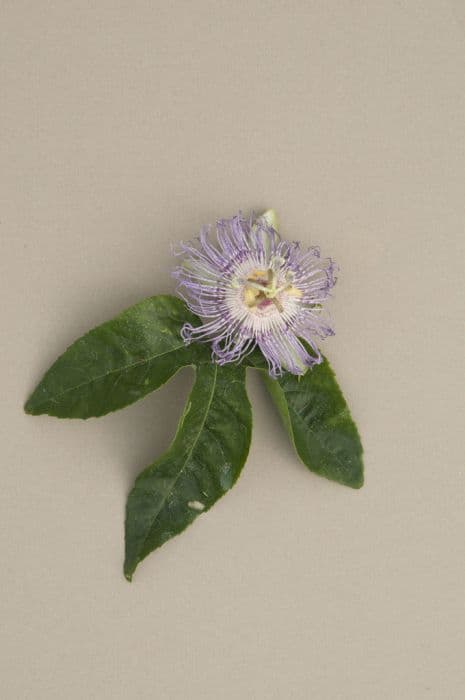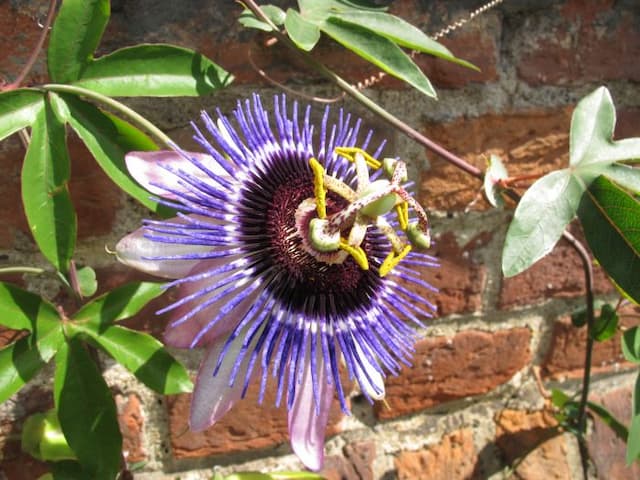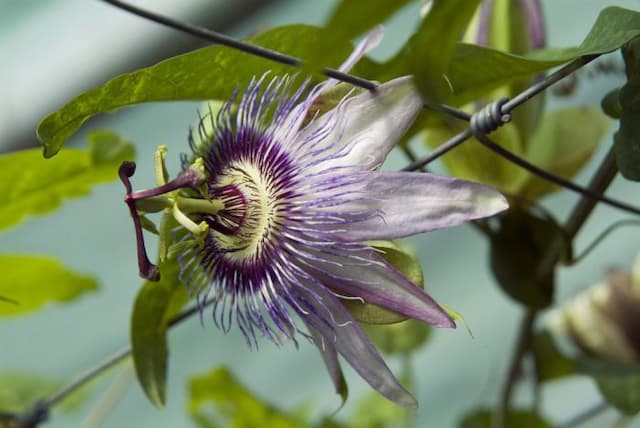Blue Passion Flower Passiflora caerulea 'Constance Eliott'

ABOUT
The plant commonly known as 'Blue Passion Flower' features an array of stunning and elaborate flowers primarily composed of a base of pure white petals. Atop these petals sits a structure that resembles a crown, made up of thin, hair-like rays that blend the colors white and light blue, giving it a delicate yet striking appearance. These radially symmetrical flowers have a ring of darker blue filaments that add a rich texture and depth to the floral display. The center of the flower has a set of three stigmas that sit above the anthers, both of which emerge from a central, ovary-bearing structure that is often green and bulbous. Surrounding the flowers are deep green, glossy leaves that are palmately lobed, which means they are shaped a bit like the palm of a hand with fingers spreading out. The lobes of the leaves commonly number five or more and have a smooth, sometimes slightly serrated edge. The foliage provides a lush backdrop for the blooms and also highlights their complexity and beauty. Adding to the charm of the Blue Passion Flower are the curly tendrils that stretch out seeking to grasp onto supports, allowing the plant to climb and showcase its flowers more prominently. These tendrils spiral and twist, adding an element of graceful movement to the plant's growth. This variety 'Constance Eliott' stands out with its particularly striking white flowers, which offer a sense of elegance and purity. It's a vigorous plant that entices not just human admirers, but also various pollinators like bees and butterflies, which are drawn to its intricate flowers.
About this plant
 Names
NamesFamily
Passifloraceae
Synonyms
Blue Passionflower, Common Passion Flower, Blue Crown Passion Flower, Constance Elliot Passion Flower
Common names
Passiflora caerulea 'Constance Elliott'.
 Toxicity
ToxicityTo humans
Blue Passion Flower, when it comes to human consumption, is generally considered to have a low level of toxicity. However, some parts of the plant, such as the leaves and unripe fruit, may contain cyanogenic glycosides, which can release cyanide when metabolized. If ingested in sufficient quantities, these compounds could potentially cause symptoms such as nausea, vomiting, drowsiness, and a slow heart rate. Ingestion of large amounts might result in more serious toxic effects, but such events are rare.
To pets
Blue Passion Flower may pose a risk to pets if ingested. Like in humans, the leaves and unripe fruit can contain cyanogenic glycosides that can release cyanide when digested, potentially leading to poisoning. Symptoms in pets could include vomiting, diarrhea, and lethargy. As with humans, serious poisoning is uncommon among pets, but it’s advisable to keep animals away from the plant to prevent any consumption of potentially toxic parts.
 Characteristics
CharacteristicsLife cycle
Perennials
Foliage type
Semi-deciduous
Color of leaves
Green
Flower color
White
Height
10 feet (3 meters)
Spread
6 feet (1.8 meters)
Plant type
Climber
Hardiness zones
6
Native area
South America
Benefits
 General Benefits
General Benefits- Attractive Flowers: The Blue Passion Flower produces beautiful white flowers with a striking central crown of blue or violet, which can enhance the beauty of any garden.
- Pollinator Support: It attracts bees, butterflies, and other beneficial insects, providing necessary support for pollination.
- Food Source: The edible fruits serve as food for wildlife and can be consumed by humans when ripe.
- Shade Provider: When grown over arbors or trellises, it can provide shade and reduce heat in garden sitting areas or patios.
- Privacy Screen: Its dense foliage and rapid growth make it an effective natural screen for increased privacy.
- Vertical Interest: It is ideal for adding vertical interest in the garden, capable of climbing walls, fences, and trellises.
- Easy to Grow: It is a hardy vine that is relatively easy to care for and can thrive in a variety of soil conditions.
- Perennial Growth: Being a perennial plant, it can provide enjoyment year after year with proper care.
 Medical Properties
Medical Properties- Anxiety relief: Blue Passion Flower, which includes Passiflora caerulea, is sometimes used to help reduce symptoms of anxiety.
- Insomnia treatment: Compounds in the plant may have a mild sedative effect, hence its use for aiding sleep.
- Anti-inflammatory effects: Certain phytochemicals present in Passiflora caerulea might exhibit anti-inflammatory properties.
- Relief from menopausal symptoms: There are claims that it could alleviate hot flashes and hormonal-induced irritability.
- Muscle spasm relief: It is thought to contain compounds that could help ease muscle tension.
- Analgesic effects: Some suggest that it may have mild pain-relieving properties.
 Air-purifying Qualities
Air-purifying QualitiesThis plant is not specifically known for air purifying qualities.
 Other Uses
Other Uses- Passiflora caerulea, commonly known as Blue Passionflower, can be used in educational settings to demonstrate plant structure and pollination techniques to students.
- Insect habitat creation, as the Blue Passionflower can provide a home and nourishment for a variety of insects, including bees and butterflies.
- Culinary ingredient in exotic or tropical-themed dishes, where the edible petals or fruit of the Blue Passionflower can be utilized.
- As a natural dye source, where the petals and fruits can provide pigments for fabric or craft projects.
- Religious and cultural symbol, as it's often associated with various Christian iconography and symbolism, especially during Easter.
- Landscape architecture, where the Blue Passionflower is used to create visually striking green walls and fences.
- Crafting and decoration, where dried parts of the plant can be used in floral arrangements or wreaths.
- Companion planting, as it can attract pollinators and beneficial insects to gardens, supporting the growth of vegetables and fruits.
- Nature photography, where the intricate and vibrant flowers serve as a compelling subject for photographers.
- Drama and theater as a prop or scenic element in plays or movies that require lush, tropical vegetation.
Interesting Facts
 Feng Shui
Feng ShuiThe Blue Passion Flower is not used in Feng Shui practice.
 Zodiac Sign Compitability
Zodiac Sign CompitabilityThe Blue Passion Flower is not used in astrology practice.
 Plant Symbolism
Plant Symbolism- Passion and Suffering: As a species of passionflower, Passiflora caerulea 'Constance Eliott' symbolizes the passion of Jesus Christ in Christian tradition. Its different parts represent aspects of the Crucifixion, such as the crown of thorns, the five wounds, and the three nails.
- Spiritual Enlightenment: The striking radiance and unique appearance of the flower are often associated with an awakening or enlightenment, suggesting a transcendent significance.
- Purity: The 'Constance Eliott' variety, with its white flowers, is particularly associated with purity and innocence.
- Peace: The serene appearance of the flower can symbolize peace and calm, offering a sense of tranquility to those who gaze upon it.
- Heavenly Aspirations: The upward growth and reaching tendrils of the vine suggest an aspiration towards the heavens and spiritual goals.
 Water
WaterThe Blue Passionflower should be watered when the top inch of soil feels dry to the touch, which typically equates to once a week, depending on climate and weather conditions. It is important to ensure that the plant receives thorough watering, allowing water to reach deep into the roots. For a potted plant, this might mean using approximately 1-2 gallons of water, ensuring excess water can drain out of the bottom of the container. In hotter months, more frequent watering may be necessary, while in winter, water less often. Always avoid letting the plant sit in waterlogged soil as this can lead to root rot.
 Light
LightThe Blue Passionflower thrives best in full sun to partial shade. It should be placed in a spot where it receives at least six hours of direct sunlight daily but is shaded during the hottest part of the afternoon, if possible. A south-facing or west-facing location is typically ideal for providing the light conditions that the Blue Passionflower prefers.
 Temperature
TemperatureBlue Passionflower can tolerate a temperature range from about 35°F to 85°F. However, the ideal temperature for thriving growth is between 50°F and 75°F. It can survive mild frosts but should be protected from severe cold snaps below 32°F. During extreme heat above 90°F, the plant may require additional shading and watering to maintain its health.
 Pruning
PruningPruning the Blue Passionflower is essential for maintaining its shape, encouraging bushier growth, and removing dead or overgrown tendrils. Prune in early spring before new growth begins, trimming back to healthy buds to stimulate new vine production. Also, remove any frost-damaged growth after the last expected frost date. It can be pruned lightly throughout the growing season to maintain a manageable size.
 Cleaning
CleaningAs needed
 Soil
SoilBlue Passion Flower thrives in well-draining soil rich in organic matter with a pH range of 6.5 to 7.5. A mixture of loamy garden soil, peat, and compost, with an addition of perlite or sand for improved drainage, creates an ideal environment for its roots to grow strong and healthy.
 Repotting
RepottingBlue Passion Flower should be repotted every 2 to 3 years, or when it has outgrown its current pot, to provide it with fresh soil and encourage continued growth. Young plants may need to be repotted more frequently.
 Humidity & Misting
Humidity & MistingBlue Passion Flower prefers moderate to high humidity levels, ideally between 40-60%. This tropical plant will thrive if the air around it retains some moisture, as too dry conditions can stress the plant.
 Suitable locations
Suitable locationsIndoor
Provide bright light, moderate watering, and trellis for climbing.
Outdoor
Full sun, shelter, well-drained soil, and space for vines.
Hardiness zone
6-9 USDA
 Life cycle
Life cycleBlue passionflower (Passiflora caerulea 'Constance Eliott') begins its life cycle when seeds germinate, typically requiring warm temperatures to sprout. After germination, the seedling develops into a vigorous vine, exhibiting rapid growth and producing lobed, dark green leaves. As it matures, the vine produces unique white flowers with a central crown of filaments, characteristic of the passionflower family, during the warmer months. Following pollination, which is often aided by bees and other insects, the flowers may develop into oval orange-yellow fruits containing numerous seeds. The vine is perennial in favorable climates, going dormant in winter in colder regions only to regrow from the roots in spring. Throughout its life, Blue passionflower requires ample sunlight, well-drained soil, and, in many cases, a structure to climb on for support.
 Propogation
PropogationPropogation time
Spring-Early Summer
The most popular method for propagating the Blue Passionflower, 'Constance Eliott', involves taking softwood cuttings in late spring or early summer. This period coincides with the plant's active growth phase, making it ideal for rooting new plants. To propagate using this method, carefully cut a 4-6 inch (10-15 cm) length of new, soft growth from the parent plant. The cut should be made just below a leaf node, and the bottom leaves should be removed. The cutting can then be dipped in rooting hormone to encourage root development and planted in a pot filled with a moist, well-draining potting mix. Covering the cutting with a plastic bag can help maintain humidity levels. With proper care, including keeping the soil consistently moist, roots should develop within a few weeks, and the cutting can eventually be transplanted to a larger pot or directly into the garden.









